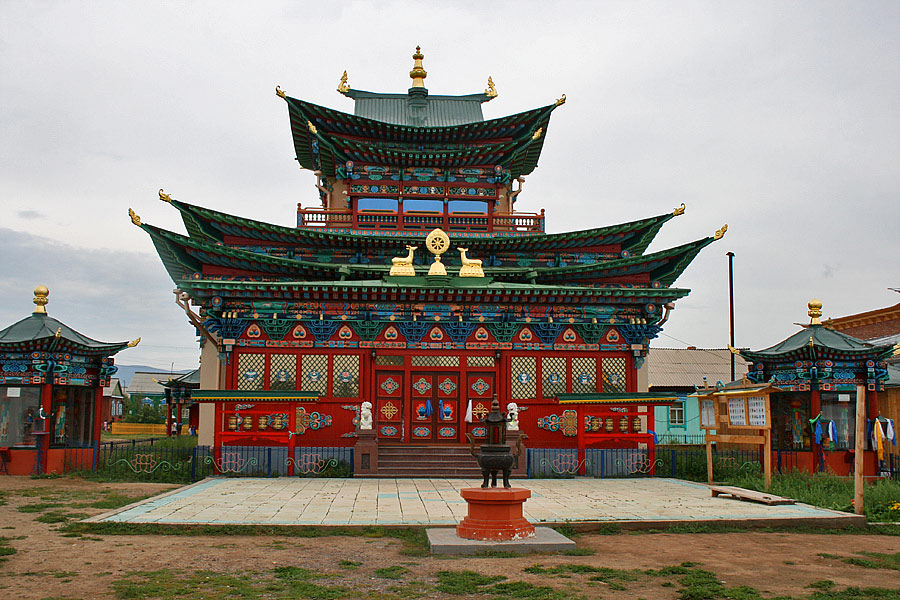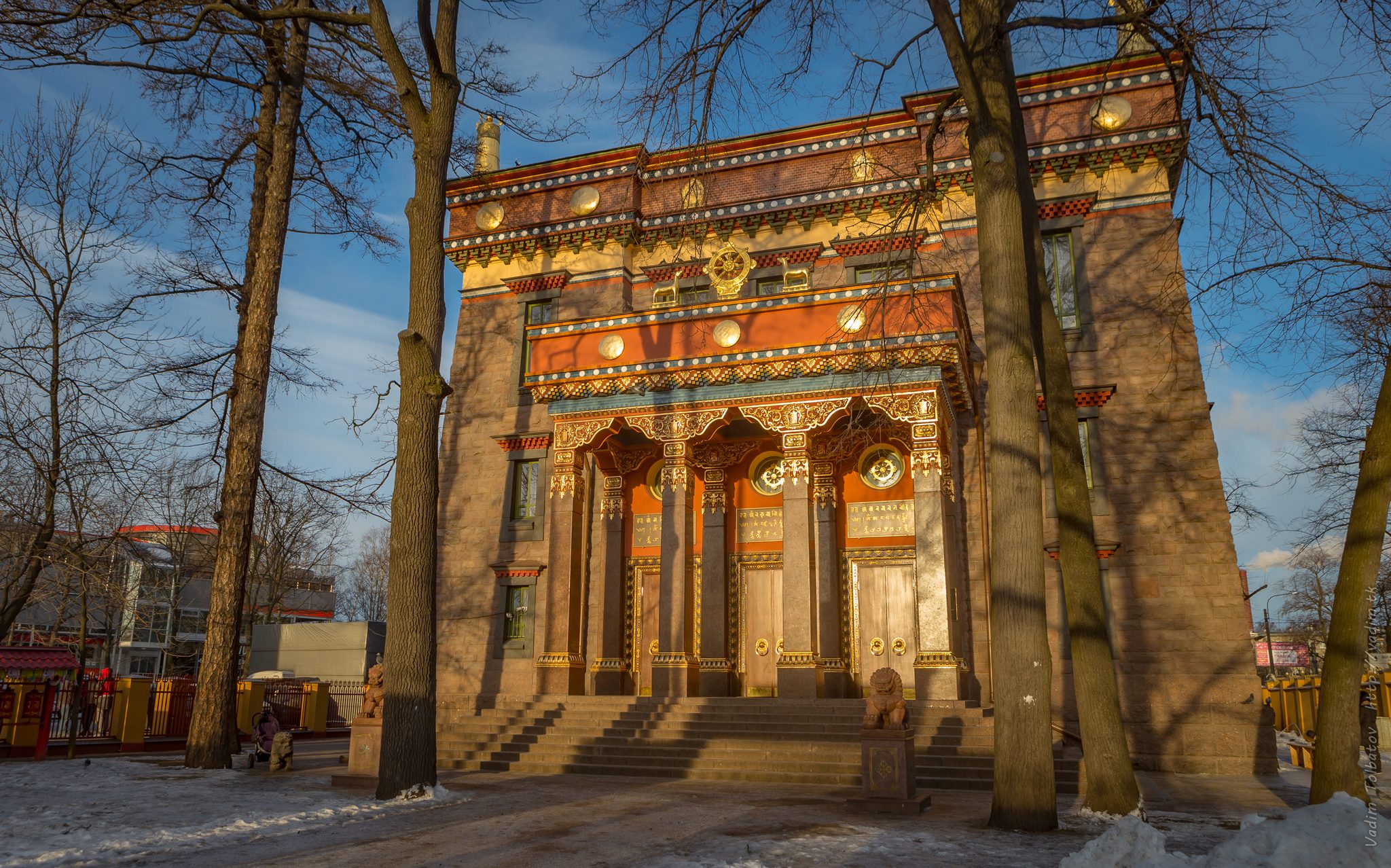|
Datsan
Datsan (, , ; ''derived from'' ) is the term used for Buddhist university monastery, monasteries in the Tibetan tradition of Gelukpa located throughout Mongolia, Tibet and Siberia. As a rule, in a datsan there are two departments—philosophical and medical. Sometimes a department of tantra, tantric practices is added to them where the monks study only after finishing education in the philosophical department. In pre-Russian Revolution (1917), revolutionary Russia, datsans traditionally existed only in the Buryats, Buryat territories, most of those now included in Republic of Buryatia, Buryatia and Transbaikalia (a number of datsans there have been reconstructed or newly established since the early 1990s). There was a difference with Tibetan administrative idea: in Tibet, several datsans were education-centered parts of larger organizations,Rinchen, B.; Maidar, D., ed. (1979). Mongol ard ulsiin ugsaatnii sudlal, khelnii shinjleliin atlas [Ethnographic and Linguistic Atlas of t ... [...More Info...] [...Related Items...] OR: [Wikipedia] [Google] [Baidu] |
Ivolga Monastery
Ivolginsky Datsan () is the center of the Buddhist Traditional Sangha of Russia. It is a Buddhist temple located in Republic of Buryatia, Buryatia, Russia, 23 km from Ulan Ude, Ulan-Ude, near Verkhnyaya Ivolga village. The spiritual activity of the ''datsan'' is manifested in temple rites, medical practice, and a traditional system of Buddhist education. History The ''datsan'' opened in 1945 as the only Buddhist spiritual centre of the USSR. Its name was changed from Khambin ''Sume'' () to the Monastic Centre (). It was the residence of the Central Spiritual Board of Buddhists of the USSR and later of the Buddhist Traditional Sangha (Buddhism), Sangha of Russia, as well as that of Pandido Khambo lama, the head of the Russian Buddhists. The Dashi Choinkhorling Buddhist university was opened in 1991 attached to the datsan. Culture Although built in the late 1940s with light-colored brick, the [main] temple displays traditional proportions and ornamentation. The first l ... [...More Info...] [...Related Items...] OR: [Wikipedia] [Google] [Baidu] |
Ivolginsky Datsan
Ivolginsky Datsan () is the center of the Buddhist Traditional Sangha of Russia. It is a Buddhist temple located in Buryatia, Russia, 23 km from Ulan-Ude, near Verkhnyaya Ivolga village. The spiritual activity of the ''datsan'' is manifested in temple rites, medical practice, and a traditional system of Buddhist education. History The ''datsan'' opened in 1945 as the only Buddhist spiritual centre of the USSR. Its name was changed from Khambin ''Sume'' () to the Monastic Centre (). It was the residence of the Central Spiritual Board of Buddhists of the USSR and later of the Buddhist Traditional Sangha of Russia, as well as that of Pandido Khambo lama, the head of the Russian Buddhists. The Dashi Choinkhorling Buddhist university was opened in 1991 attached to the datsan. Culture Although built in the late 1940s with light-colored brick, the aintemple displays traditional proportions and ornamentation. The first level is devoted to study and prayer. The second leve ... [...More Info...] [...Related Items...] OR: [Wikipedia] [Google] [Baidu] |
Khurul
image:Khoshotovsky Khurul 1812.jpg, Khosheutovsky khurul A khurul (; or ''hure'' or ''küriye'') is a Buddhist monastery (temple, abode) in Kalmyks, Kalmyk (Oirats, Mongol-Oirat) Tibetan Buddhism, Lamaism. Some of the most famous Kalmyk khuruls are the Burkhan Bakshin Altan Sume (contemporary) in Elista, Republic of Kalmykia, Russia, and the Khosheutovsky khurul (which was originally in the Kalmyk Autonomous Oblast, Kalmyk AO / Kalmyk Autonomous Soviet Socialist Republic, Kalmyk ASSR, but is now located in Astrakhan Oblast, Russia). Etymology and morphology Among Kalmyks and Tuvans, the term khurul (хурул) is the common name for Buddhist monasteries and temples in Kalmykia, Tuva, Mongolia, and Buryatia, though, they have been renamed to ''datsan'' in the latter. The word ''khurul'' derives from the Mongolian language, Mongolian word ''khure'' (хурэ, ), which means "circle", "ring", "inclosure", and/or from the Mongolian word ''khural'' (хурал) which means "assembl ... [...More Info...] [...Related Items...] OR: [Wikipedia] [Google] [Baidu] |
Datsan Gunzechoinei
The Datsan Gunzechoinei (, , ) is a large Buryat Buddhist datsan in Saint Petersburg, Russia. Before building the datsan in Yakutsk in 2014, it was the only northernmost Tibetan Buddhist temple in Russia. History In 1909, Agvan Dorzhiev got permission from the Tsar to build a large and substantial Buryat Buddhist ''datsan'' or temple in Saint Petersburg which he hoped would become the residence of the first Buddhist ruler of Russia. However, the Russian Orthodox Church campaigned strongly against construction of this "pagan" temple across the country, which considerably delayed its construction. However, the first service was held on 21 February 1913, and construction was completed by 1915, when Tsar Nicholas II confirmed the arrival of a staff of nine lamas: three from Transbaikalia, four from Astrakhan Province, and two from Stavropol Province. The stained glass windows were commissioned from Nicholas Roerich. A second large service was held on 9 June 1914 to consecra ... [...More Info...] [...Related Items...] OR: [Wikipedia] [Google] [Baidu] |
Rinchin Datsan
Rinchin Datsan () is a Buddhist monastery in Sovetsky City District of Novosibirsk, Russia. It was opened in 2015. History In 2012, the construction of the datsan began in Nizhnyaya Yeltsovka (microdistrict of Novosibirsk). The Rinchin Datsan was opened in 2015. Eight lamas from Novosibirsk, Khakassia, Buryatia, Tuva and Gorny Altai took part in its opening, they walked around the temple an odd number of times in the direction of the sun, and then distributed to parishioners consecrated rice. Part of the altar items for the datsan brought from Nepal Nepal, officially the Federal Democratic Republic of Nepal, is a landlocked country in South Asia. It is mainly situated in the Himalayas, but also includes parts of the Indo-Gangetic Plain. It borders the Tibet Autonomous Region of China Ch .... A larger temple is being built inside the territory of the religious complex. In the summer of 2019, the construction of a new Buddhist temple was almost completed. [...More Info...] [...Related Items...] OR: [Wikipedia] [Google] [Baidu] |
Buryats
The Buryats are a Mongolic ethnic group native to southeastern Siberia who speak the Buryat language. They are one of the two largest indigenous groups in Siberia, the other being the Yakuts. The majority of the Buryats today live in their titular homeland, the Republic of Buryatia, a federal subject of Russia which sprawls along the southern coast and partially straddles Lake Baikal. Smaller groups of Buryats also inhabit Ust-Orda Buryat Okrug (Irkutsk Oblast) and the Agin-Buryat Okrug (Zabaykalsky Krai) which are to the west and east of Buryatia respectively as well as northeastern Mongolia and Inner Mongolia, China. Traditionally, they formed the major northern subgroup of the Mongols. Buryats share many customs with other Mongolic peoples, including nomadic herding, and erecting gers for shelter. Today the majority of Buryats live in and around Ulan-Ude, the capital of the Buryat Republic, although many still follow a more traditional lifestyle in the countryside. ... [...More Info...] [...Related Items...] OR: [Wikipedia] [Google] [Baidu] |
Aginskoye, Zabaykalsky Krai
Aginskoye (; , ''Aga''; , ''Ag'') is an urban locality (an urban-type settlement) and the administrative center of Agin-Buryat Okrug and of Aginsky District in Zabaykalsky Krai, Russia. It is located in the valley of the Aga River (the Amur basin). Population: 7,200 (1967). History It was founded in 1781Registry of the Administrative-Territorial Units and the Inhabited Localities of Zabaykalsky Krai or, according to other sources, in 1811.Агинское Administrative and municipal status Within the[...More Info...] [...Related Items...] OR: [Wikipedia] [Google] [Baidu] |
Ulan-Ude
Ulan-Ude (; , ; , ) is the capital city of Buryatia, Russia, located about southeast of Lake Baikal on the Uda River, Buryatia, Uda River at its confluence with the Selenga River, Selenga. According to the Russian Census (2021), 2021 Census, 437,565 people lived in Ulan-Ude; up from 404,426 recorded in the Russian Census (2010), 2010 Census, making the city the third-largest in the Russian Far East by population. Names Ulan-Ude was first called Udinskoye (, ) for its location on the Uda River (Republic of Buryatia), Uda River. It was founded as a small fort in 1666. From around 1735, the settlement was called Udinsk (, ) and was granted town status under that name in 1775. It was renamed Verkhneudinsk (, ; "Upper Udinsk") in 1783, to differentiate it from Nizhneudinsk ("Lower Udinsk") lying on a different Chuna River, Uda River near Irkutsk which was granted town status that year. The descriptors "upper" and "lower" refer to the positions of the two cities relative to each othe ... [...More Info...] [...Related Items...] OR: [Wikipedia] [Google] [Baidu] |
Geser Datsan
{{Dab, surname, given name, geo ...
Geser may refer to: * Geser/Gesar from the ''Epic of King Gesar'' * Geser F-250 4x4, fire-fighting vehicle from Switzerland * Geser, Indonesia, a village on the southeast coast of Seram Island *Geser language, a language of Seram Island *Hans Geser (1947–2025), Swiss sociologist *Geser, a fictional character in the series of novels of Russian author Sergei Lukyanenko, starting with ''Night Watch'' See also * * *Geyser *Gezer Gezer, or Tel Gezer (), in – Tell Jezar or Tell el-Jezari is an archaeological site in the foothills of the Judaean Mountains at the border of the Shfela region roughly midway between Jerusalem and Tel Aviv. It is now an List of national parks ... [...More Info...] [...Related Items...] OR: [Wikipedia] [Google] [Baidu] |
Dyrestuy
Dyrestuy (; , ''Derestei'') is a rural locality (a selo) in Dzhidinsky District, Republic of Buryatia Buryatia, officially the Republic of Buryatia, is a Republics of Russia, republic of Russia located in the Russian Far East. Formerly part of the Siberian Federal District, it has been administered as part of the Far Eastern Federal District sin ..., Russia. The population was 1,095 as of 2010. There are 10 streets. Geography Dyrestuy is located 58 km east of Petropavlovka (the district's administrative centre) by road. Dzhida is the nearest rural locality. References Rural localities in Dzhidinsky District {{Dzhidinsky-geo-stub ... [...More Info...] [...Related Items...] OR: [Wikipedia] [Google] [Baidu] |
Kutulik
Kutulik (; , ''Khutuleg'') is a rural locality (a settlement) and the administrative center of Alarsky District of Ust-Orda Buryat Okrug, Irkutsk Oblast, Russia Russia, or the Russian Federation, is a country spanning Eastern Europe and North Asia. It is the list of countries and dependencies by area, largest country in the world, and extends across Time in Russia, eleven time zones, sharing Borders .... Population: References Notes Sources * * * * *Registry of the Administrative-Territorial Formations of Irkutsk Oblast'' {{Authority control Rural localities in Irkutsk Oblast ... [...More Info...] [...Related Items...] OR: [Wikipedia] [Google] [Baidu] |






